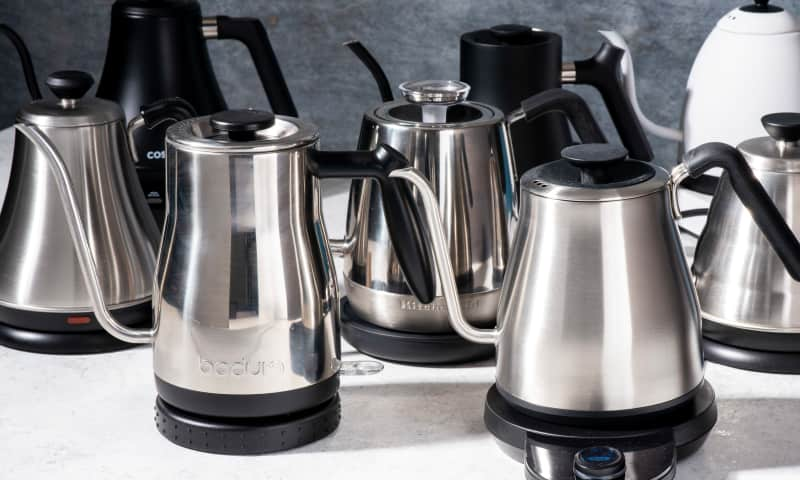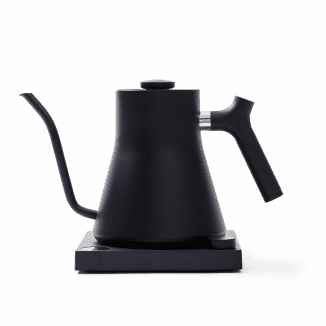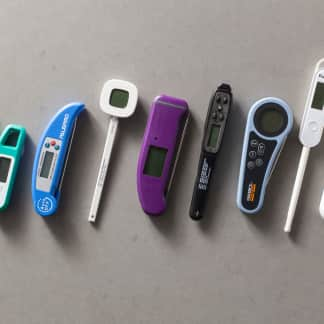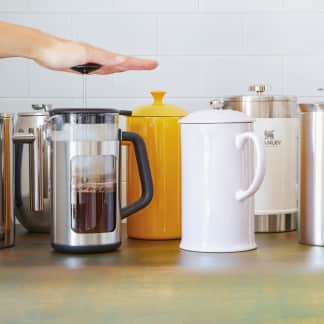Gooseneck kettles are named for their thin, elegantly curved spouts. They dispense water slowly and precisely, allowing users to hydrate coffee grounds and tea leaves gently. It’s helpful to have this level of control when making pour-over coffee, a brewing method that involves pouring a thin stream of hot water over coffee grounds to moisten them evenly for better extraction. But they’re great for normal kettle jobs, too—anything from rehydrating dried foods to making instant noodles. To find the best gooseneck kettle, we assembled a mixed lineup of kettles that only boil water and adjustable kettles, which enable the user to heat water to specific temperatures. Adjustable kettles are good if you’re into specialty coffee and tea, which require different brewing temperatures for the best extraction. With all the kettles, we timed their boiling speeds, evaluated how easy they were to operate and how comfortable they were to handle, and boiled hundreds of kettlefuls of water to see how the kettles held up to repeated use. We also tested the temperature accuracies of the adjustable kettles. We were looking for a dependable kettle that was easy to use, comfortable to maneuver, and fast.
Structural Design Determined Success
A few important design factors separated the good kettles from the bad in our tests. First: spouts. Most of the kettles’ thin spouts dispensed water slowly and precisely, but a few were a challenge to use. One model had a sliding door that covered the entrance to the spout and allowed users to choose between three pouring speeds. Some of the settings resulted in flows that were heavy and fast—helpful for tasks that require less precision but too imprecise for pour-over coffee. Selecting the slowest speed was tough: The door was too difficult to adjust and got stuck easily. Additionally, the curved spouts of a few kettles were too straight, causing us to spill water if we accidentally tilted them even a bit. We liked spouts with sharper curves, which were easier to control.

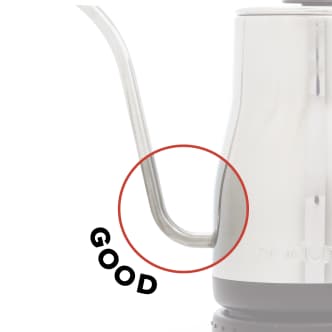
Second, we liked kettles that were large yet lightweight. The capacities of the kettles in our lineup ranged from 27 to about 40 fluid ounces. Our two favorite models each held about 34 fluid ounces but only weighed about 1½ pounds when empty. We liked that they held enough water to make at least four 8-ounce servings of coffee and were light enough that they didn’t tire our hands as we poured from them. We also liked kettles with capacity lines that could be read at a glance. Some kettles’ internal capacity lines were positioned near their handles, making us crane our necks and squint into the kettles’ depths as we filled them. We preferred clear internal markings positioned opposite the handles, which we were able to view easily as we held kettles underneath the faucet.

We liked clear internal markings positioned opposite the handles, which we were able to view easily as we held kettles underneath the faucet.
Third, we preferred kettles with handles that were comfortable to hold and maneuver when slowly dispensing water. Some handles weren’t cushioned, with bumps or ridges that forced our fingers into specific and uncomfortable positions. Handles made from softer, grippier material without bumps or ridges fit our hands better and made for easy pouring.
Finally, the designs of the kettles’ lids mattered. We preferred lids that were easy to remove and replace. Some lids scraped against the sides of kettles’ openings and had to be wrenched off. The positions and sizes of the lids’ knobs were also important. Some lid knobs didn’t sit high enough above the lids, positioning our fingers dangerously close to the lids’ steam vents. We preferred knobs that stuck out from lids by ½ inch or more.

Speed Was Key
Nobody wants to wait around endlessly for water to boil, so testing kettles’ heating speeds was essential. We started by timing how long the kettles took to boil water when filled to capacity. Then, for a clearer comparison across models, we repeated the timed test with a standardized volume of 3 cups. We conducted both tests multiple times to establish an average time range for each kettle. On average, the boil-only kettles took longer to boil: It took an average of about 5.5 minutes for the slowest boil-only kettle to boil 3 cups of water. Meanwhile, one superfast adjustable kettle blazed past its competitors, routinely boiling water in a little less than 3 minutes.

Simple Controls And Clear Alerts Were Best
For both styles of kettle, we preferred controls that were easy to operate. To start each boil-only kettle, we simply flipped a small switch on its base. Two adjustable kettles were almost as easy to use: Each had a large knob on its base that we twisted to select custom temperatures and then pressed down to activate. We preferred these knobs to the remaining adjustable kettles’ controls, which included multiple buttons that were in some cases too confusing to master quickly.

We like to be able to tell when the kettles were finished heating. We preferred indicator lights that lit up vibrantly, with bright, powerful bulbs that were easy to view even from across the room.
It was also important to be able to tell when the kettles were finished heating. The boil-only kettles didn’t emit beeps or other sounds to alert users that they were done heating, but they all had indicator lights that were illuminated when the kettles were in use. We preferred indicator lights that lit up vibrantly, with bright, powerful bulbs that were easy to view even from across the room. And while two adjustable kettles emitted loud beeps when they reached the desired temperatures, the remaining two offered no easily discernible indication that their heating cycles were finished. This forced us to hover over them as they heated, staring at their temperature displays, or risk missing the perfect temperatures we’d selected.
All the adjustable kettles can also hold their contents’ temperatures steady for at least 30 minutes after they’re finished heating (or up to an hour for some models). Two models activated this hold function automatically, but the remaining two required us to press another button at the beginning of the heating process to turn on the hold function. If we forgot, we had to heat the water again, defeating the purpose of the hold function.
Testing Adjustable Kettles’ Accuracy
The whole point of an adjustable kettle is to heat water to precise temperatures specific to certain types of teas or coffee brewing methods, rather than boiling and waiting for it to cool down, so we thoroughly tested the adjustable kettles’ accuracy. One model had four preset temperature options, and the three remaining adjustable kettles could be set to any temperature (two from 140 to 212 degrees, the other from 135 to 212 degrees). We tested the accuracies of the first kettle’s four preset temperatures and tested the others at five temperatures from 175 degrees to boiling. We measured the water temperatures throughout with our winning instant-read thermometer.
We even boiled water 365 times in our favorites, simulating a year of daily use. The good news: All the kettles held up to this abuse just fine.
Most of the kettles consistently heated water to temperatures that were between 2 and 5 degrees under their set temperatures. But one kettle was always either perfectly at temperature or only 1 degree off. The same kettle performed best when we tested the kettles’ hold functions: After heating water in each kettle and activating its hold feature, we measured the water’s temperature at regular intervals until the hold setting ended. The best kettle held its water within 1 degree for its entire 30-minute temperature hold.
Should You Buy a Gooseneck Kettle or a Regular Electric Kettle?
If you're in the market for a new electric kettle and wondering which kind to get, gooseneck or regular, here's the 411. We love our winning regular electric kettle, the OXO Brew Cordless Glass Electric Kettle, for its large capacity (about 60 ounces). Our winning gooseneck kettles have smaller capacities (each about 34 ounces), but their key feature is a curved spout that allows you to pour water with more control than the regular winner offers—perfect for pour-over coffee. We also loved the look of the elegant spouts at our coffee stations. Our take: If you're looking for controlled pouring and cuteness and aren't worried about boiling water for a crowd, go for a gooseneck. Otherwise a regular electric kettle is probably your best bet.
Testing Durability
The ideal kettle should stand up to years of everyday use. To test durability, we repeatedly washed the kettles, removed and replaced their lids, and detached them from and reattached them to their bases, all dozens of times. We knocked them over on the counter once to see if they would dent, and—most important—we boiled 50 batches of water in each kettle. We even boiled water 365 times in our favorites, simulating a year of daily use. The good news: All the kettles held up to this abuse just fine.

The Best Electric Gooseneck Kettles: Bodum Bistro Gooseneck Electric Water Kettle And Oxo Brew Adjustable Temperature Pour Over Kettle
Which kettle style is right for you? If you’re interested in the simplest experience and are looking to only boil water, we think a boil-only kettle is just fine. Adjustable kettles are generally more expensive, but they offer a few advantages, including allowing you to set precise temperatures rather than waiting for your water to cool down after you’ve boiled it and holding those temperatures in case you want another cup. In the end, we picked a winner in each style. Both the Bodum Bistro Gooseneck Electric Water Kettle and the OXO Brew Adjustable Temperature Pour-Over Kettle are lightweight and have large capacities, easy-to-read capacity lines, and comfortable handles. They boiled water the quickest out of all the kettles in their respective categories. The Bodum model’s on-off switch lights up in a bright electric blue that we couldn’t miss, even from across the kitchen. The OXO model’s single knob couldn’t be simpler to operate, and it was the most accurate adjustable model in our lineup. Its automatic 30-minute hold function consistently kept water within 1 degree of the target temperature for the promised half-hour. Depending on your needs, either kettle could help streamline your morning routine.
- Measure the average boiling speed at each kettle’s maximum capacity
- Measure the average boiling speed with a standard volume of 3 cups
- Make pour-over coffee
- Boil water 50 additional times
- Remove and replace the lid 50 additional times
- Remove and return each kettle to its base 100 additional times
- Wash each kettle 10 additional times
- Knock each kettle over on the counter
- For adjustable kettles: Measure the accuracy at preset or custom temperatures
- For adjustable kettles: Test the kettle's ability to hold a temperature over time
- Winners only: Boil water 365 additional times
- Sharply curved spout that dispenses slowly
- Weighs less than about 1½ pounds when empty
- Capacity of more than 33 ounces
- Easily visible capacity line
- Comfortable handle
- Boils 3 cups of water in 4 minutes or less
- Easily interpretable controls
- Durable
